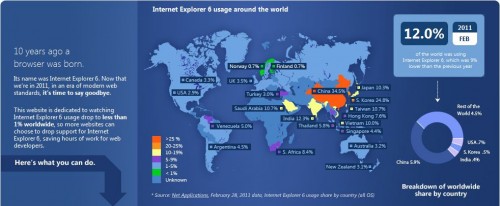Microsoft is stepping up its efforts to wean the world off Internet Explorer 6 (IE6). A new website has been created by the Redmond company just to watch the aging browser die.
It sounds kind of morbid to put it that way, but for a slow and insecure web browser to stick around for 10 years causes a lot of trouble for web developers. They often have to take into account the different page rendering capacities of old browsers in creating web pages.
According to the website, 12% of the world is still using IE6, with China being the worst perpetrator — a whopping 34.5% of web surfers there are still on IE6. Singapore, being generally tech-savvy, still sees about 4.4% of usage. A very curious phenomenon indeed, since two new versions of Internet Explorer has been released since then, and a third newest one has hit Release Candidate status.
Recognising that a percentage of these people still using IE6 are doing so in corporate settings, Microsoft also put together some links to help convince IT departments to move to IE8. The list includes case studies and migration tips.
So how can you play a part in this race to kill IE6? Why, put a banner on your site informing your visitors, of course! Only IE6 users will be able to see this banner, and clicking on it will bring them to a site prompting them to upgrade.
If you’re reading Techgoondu, chances are you’re tech-savvy enough to be using a more modern browser. And if you’re not, do upgrade now! IE6 is one of the least secure browsers out there (if not the least secure) and your browsing experience would be greatly enhanced by choosing any other browser.
Are you still forced to use IE6 at work? Let us know in the comments!






Hey Chi Long, I think your comment should be an article 😉
Cae, IE9 is really quite decent! 🙂
“Friends don’t let friends use IE6″ says Microsoft
The truth should be
“Friends don’t let friends use any version of IE, go for Firefox or Chrome ″ says us 🙂
I work for a social media cloud start-up as my main job besides running Techgoondu as one of the founders and editors.
So when you work in an young start-up with brilliant techies whose job is to do primarily web-based software, browsers become a thing that you don’t just use as a consumer, it’s something that you eat and breathe every single day.
My tech colleagues have contributed their expert comments on IE9, but I can tell you for certain that they hate IE6 with a passion.
The type where you could drown cute kittens in kerosene, toss a lighted match and watch the whole thing combust and burn without shedding a single tear. Yeah, that much hate.
What’s more interesting is that I’m the sales and business development guy who has to tell them to think about looking into IE6 issues simply because our clients have asked for it.
Who are these clients? To reveal names would get me drawn and quartered, so suffice to say that they tend mostly to be in big bureaucracies. And they are more numerous than you think.
One memorable email I had to send to a client had me explaining why IE6 was “buggy and insecure”, and it didn’t support a lot of things — e.g. transparent PNGs, CSS-support for things web coders take for granted, etc.
For this, my company’s tech folks had to write ugly hacks just to support IE6. And adding any IE6 support would bloat man hours and costs significantly, according to my tech staff.
Even Google had stopped supporting IE6 in March 2010 for YouTube and Google Docs, so let alone a small company like us. Microsoft stopped supporting IE6 for XP SP2 in July 2010, but the darn support for XP SP3 is still there till 2014.
Here are some older links I dredged out of my email to substantiate my case:
Techcrunch: A Funeral held for IE6
PC World: IE6’s ‘Death’ Spurs Web Designers to Celebrate
Wikipedia entry on IE6
Luckily, the client relented and didn’t push it. But I’ve other clients who still use IE6.
Based on my experience, and having quite a few friends working in cloud-based start-ups and/or are web coders, I can say that IE6 woes are still prevalent.
And so yes, it’s great that IE6 gets more and more marginalized every year.
IE 6, unfortunately, is still ridiculously prevalent in our environment.
I’m going to argue that later in another comment based on real-life experiences, but at least I can quote stats from off our web stat tracker that we’ve installed for WordPress, which Techgoondu runs on.
In the last past month, the most popular browser is Firefox 3 (27 percent), followed by IE6 (21 percent) and then Chrome (13 percent).
Can’t wait for IE6 to die, but I’ll leave that for another comment below.